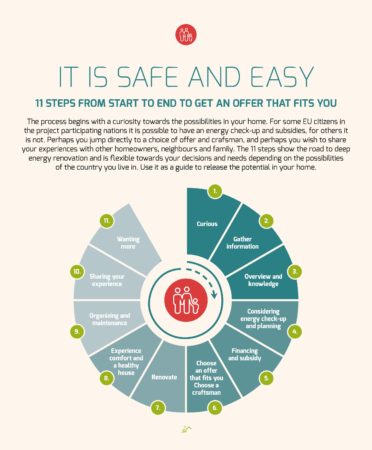Results
A tailored segmentation of the nZEB house renovation market was developed, by using: behaviour study, psychology, sociology, economics, technology, legislation, architecture, building physics and urbanism. This provided an insight into how homeowners decide, plan and think, and in particular, how this could affect their choice to invest (or not) in NZEB home renovation. As a result, a matrix was used as a tool to design tailor-made segments, which resulted in identification of high-potential market segments in Europe to design nZEB renovation packages for: “young families”, “Post-war suburbs with detached houses”, “Empty nesters”, “Terraced houses with a high energy bill”, “Convinced energy savers”, and “Homeowners of multi-apartment dwellings”.
REFURB found that these segments face similar drivers or barriers. However, local critical success factors to tackle barriers and activate drivers for housing renovation differ in the REFURB’s participating regions. It was observed that local conditions may play an important role, through local legislation, the mobility of homeownership, subsidy schemes, acceptance of renewable energy, building sector readiness for NZEB, the tradition of staged renovations.
The REFURB project also made an in-depth analysis of 10 existing demand aggregation schemes based on best practice experiences. Focus was given to analyse their success factors, fail factors, and how to reduce the drop-out moments of homeowners. Based on the analysis findings, a set of recommendations on the best way to organize the demand side was provided.
The customer journey model (as seen below) was found as the best model to encourage homeowners to invest in NZEB-renovations.
Based on the findings of the critical success and critical fail factors in the Customer Journey the REFURB partners formulated recommendations for continuous improvement of the Customer Journey towards nZEB. REFURB confirmed that the main barriers in the residential sector relate to fragmentation of the renovation offer, resulting in inefficient or only partial solutions. In addition to financial restrictions and unclear benefits, homeowners do not have a structured way to obtain all the necessary information.
REFURB also analysed what is driving homeowners to renovate their home to NZEB, in the eyes of the supply side. Both drivers and barriers were researched. This resulted in a list of categories of demand-side drivers and barriers. It was found that the supply sides’ perception of the drivers of the demand side is very approximate to the real drivers of the demand side.
The REFURB project formulated recommendations to which existing renovation solutions can be used in renovation packages that are offered to homeowners to stimulate them to renovate their house to NZEB. Out of the examples of one-stop-shop concepts analysed in Europe, the common characteristics of existing one-stop-shop-solutions were identified. It was clear that the specific country context determined the success of the one-stop-shop solutions. Furthermore, many of the analysed one-stop-shop-solutions are not isolated initiatives. Most of them are embedded in a much broader programme, project or campaign, with clear demonstration projects, etc.
Further step towards the REFURB aim was through investigation on the suitable financing constructions specific for energy efficient house renovations. It was found that there are number of financial stimuli to reward homeowners when they conduct nZEB renovation. This can be coaching, grants and subsidies for individual energy-efficiency related renovation measures of the building envelope or the technical installations, or tax stimuli such as tax deduction for selected renovation measures or tax reduction on a property in case of achieving a certain energy efficiency level with the renovation.



